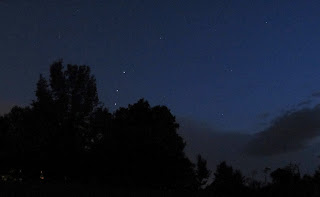The moon moved into the Saturn, Mars, Spica triangle last night. Tonight, it slides farther east leaving the trio behind. As the night's proceed, Mars also moves eastward, but very slowly, breaking apart the equilateral triangle and forming an isosceles triangle with Saturn and Spica. By the end of August, Mars begins approaching Zubenelgenubi in Libra.
In the photo Saturn is at the top and Spica lies near the bottom, just peeking above the trees. Mars is at the left, and, of course, the moon needs no introduction.
Such is our view from Earth...
In the photo Saturn is at the top and Spica lies near the bottom, just peeking above the trees. Mars is at the left, and, of course, the moon needs no introduction.
Such is our view from Earth...







